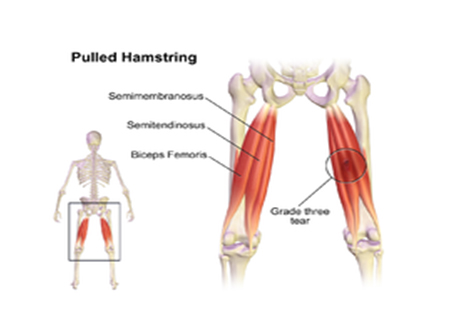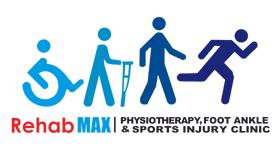Hamstring strain

The hamstrings are the three muscles at the back of the thigh. At the top, they are attached to the ‘sit bone’ of the pelvis. The lower ends cross the back of the knee joint and are then attached to the bones of the lower leg:
Semitendinosus – attaches to the back of the shin bone (tibia) on the inside of the back of the knee
Semimembranosus – also attaches to the back of the shin bone (tibia) on the inside of the back of the knee
Biceps femoris – attaches to the top of the smaller bone of the lower leg (fibula) on the outside of the back of the knee.
Hamstring strain injuries remain a challenge for both athletes and clinicians, given the high incidence rate, slow healing, and persistent symptoms. Prevalence ranges from 8 to 25 percent, depending upon the sport. In soccer, it is the most frequent injury.
Hamstring strains are common in sports with a dynamic character like sprinting, jumping, where quick eccentric contractions are regular. Besides running, kicking is another activity in which hamstring muscle strain injuries occur frequently.
Hamstring strains are caused by a rapid extensive contraction or a violent stretch of the hamstring muscle group which causes high mechanical stress. This results in varying degrees of rupture within the fibers of the musculotendinous unit.
Acute or sudden hamstring strains usually happen in two ways, either sprinting-related or stretch-related. During sprinting the hamstring muscles work extremely hard to decelerate the shin bone just before the foot strikes the ground and it is at this point that the hamstring is most likely to tear. Stretch-related injuries usually occur higher at the back of the thigh in the tendon of the semimembranosus muscle. Sprinting-related hamstring injuries often feel worse but recover more quickly, whereas stretch-related hamstring strains can take longer to heal as the injury is more likely to the tendon where blood flow is lower.
Symptoms of a hamstring strain include:
Hamstring strains are graded:
Grade 1:
- Overstretching without tearing of muscle or tendon fibers
- Symptoms may not present until the activity is over
- Usually no loss of muscular strength or flexibility
- Increased tightness in the muscle during stretch or through a full range of motion
- A feeling of pain may be reported with sitting or while walking uphill or ascending stairs
- Depending on the severity, weight-bearing activities may or may not be possible, walking properly may be possible and there will be minimal swelling
Grade 2:
- Partial tear in the muscle
- Muscular strength and flexibility in reduced
- Pain is more immediate and more severe than the pain of a Grade 1 strain
- Pain on stretch and contraction of the muscle, and is usually sore to touch
- Limping is likely during walking and occasional sudden twinges of pain during activity may occur
- Bending the knee against resistance will cause pain and there may be some difficulty in fully straightening the knee.
Grade 3:
- Severe or complete rupture of the muscle
- Sudden, sharp pain in the back of the thigh
- Walking is not possible without pain
- After a few days with Grade 2 and 3 injuries, a large bruise may appear below the injury site caused by bleeding within the tissues
- May require surgical repair
Treatment–
- The immediate treatment of any soft tissue injury consists of the RICER protocol – rest, ice, compression, elevation, and referral. RICE protocol should be followed for 48–72 hours. The aim is to reduce the bleeding and damage in the muscle. The muscle should be rested in an elevated position with an ice pack applied for 20 minutes every two hours
- After the initial acute stage, very gentle stretching exercises for the hamstring can begin
- Tendons like loads, but not erratic loads. Progressive loading of tendons has to be done in order to strengthen the hamstring muscles and avoid recurrence of injury
- Strengthening exercises for the Glutes and core are an important component of the rehab program in order to equally manage the excessive load placed on the hamstring muscle
- Eventually, sport-specific exercises and drills should be performed before returning to full competition or training.
Gradually the athlete progresses to gentle jogging and shuttle runs. Finally, acceleration runs and sprinting speed is gradually developed.
Prognosis:
Timeframes for rehabilitation and return to sport vary depending on the nature and severity of the strain. As a general rule, Grade 1 hamstring strains should be rested from sporting activity for about three weeks and Grade 2 injuries for a minimum of four to eight weeks. In the case of a complete rupture (Grade 3 strain), the muscle may have to be repaired surgically and the rehabilitation to follow will take about three months.
Premature return to sport and inadequate rehabilitation will reduce the impact of sports injury rehabilitation programs and increase the chances of re-injury. Full stretch and strength should be achieved in addition to the ability to perform full-speed training. Assessment of sport-related activities, such as twisting, jumping, and changing direction suddenly should also be evaluated.

